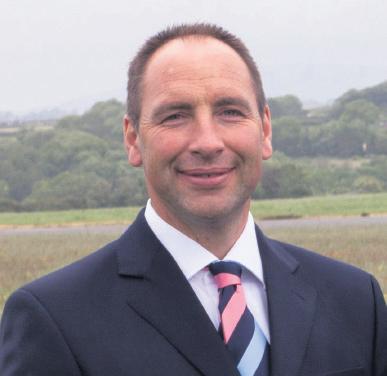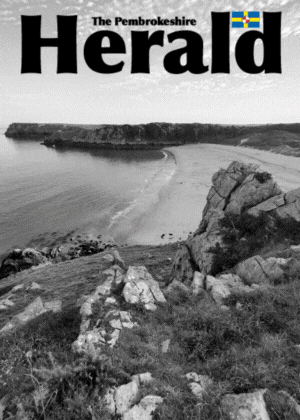News
Letters reveal hostility to school plans


Criticised: Council leader Jamie Adams
THE HERALD has seen correspondence between the Chair of the Tasker Milward and Picton Charity and Council Leader Jamie Adams that casts doubts on the legality of the Council”s revised proposals for the reorganisation of secondary education in mid and north Pembrokeshire.
The letter, dated September 8, takes Cllr Adams to task over the way the Council appears to have prejudged and predetermined the outcome of any fresh consultation.
Speaking to The Herald last Friday, former Council leader Maurice Hughes said: “It seems to me that talking about consultation with us and then telling parents of children in St Davids that their children will be going to Pembrokeshire College after the age of sixteen, gives the game away about just how much consultation and compromise the Education Department has in mind.”
Demonstrating that the Trustees of the Charity are not prepared to back down, Maurice Hughes” letter reads:
“The Trustees have become aware of the revised proposals (discussed at Council Thursday, September 10) and have taken advice on them. In relation to the proposals for Fishguard and St Davids, one recommendation is that post 16 provision should be in a new sixth form centre as part of a formal collaboration between the County Council and Pembrokeshire College.”
It goes on to point out that proceeding with consultation and publication would represent a predetermination of any subsequent proposals affecting Haverfordwest”s schools, rendering them unlawful. “Any consultation document,” the letter continues, “would itself be in breach of a number of provisions of the statutory code.”
Concluding the letter queries just what mutually satisfactory settlement the council is contemplating if it has already decided where the town”s pupils are to be educated after the age of sixteen.
A further missive was sent to all councillors by the Governors of Tasker Milward and Sir Thomas Picton Secondary Schools.
The letter discloses that a meeting took place between Ian Westley, Kate Evans-Hughes and the chairs of the schools” governining bodies.
It continues: “Various ideas were considered in the hope that a compromise solution could be found to suit all parties.
“Site locations were considered but the main sticking point is that we, the Governors, together with the staff, the pupils, and vast numbers of the local population, require to retain choice of education in the area which in effect means a new 11 – 19 year school in Haverfordwest incorporating a 6th form.”
Citing that the original recommendation of the council’s own specialists (Tribal) was that the 6th form should be run through a secondary school on or near a school site, the letter maintains that the reasoning behind the council’s desire to shuffle sixth formers off to Pembrokeshire College is ‘highly suspect’.
In addition, a new strand of debate is developed. The letter suggests that the Council’s long term plan is to shift all of Pembrokeshire’s sixth form provision to the proposed Pembrokeshire College Centre (which would chime with the original aim to put all post-14 education under the College, as revealed by Council Leader Jamie Adams nearly two years ago).
In relation to that prospect the letter points out: ‘The population of Haverfordwest has been particularly vociferous in its opposition to a 6th form centre and we feel that when it actually dawns on the population of south Pembrokeshire that their schools may suffer the same fate, individuals will at last awake’.
Criticising the local authority for seeking to site a new school on the smaller of the two available sites in Haverfordwest, the letter pours scorn on the proposal its authors say they ‘find it incredulous that this site has been chosen for what will in effect be a much larger school than currently exists on its grounds”.
On a final note, councillors are left in no doubt of the strength of the opposition to its plans: ‘We remain vehemently against any funding being routed through Pembrokeshire College, or the pupils being placed on that site.
‘If the Council does not listen to the voice of the people, it will be this Council which will have lost 21st Century funding.”
Entertainment
What’s not to love about Prince Nathaniel of Neyland?

VAIN, enthusiastic, dramatic and utterly loveable, Prince Nathaniel of Neyland is set to steal hearts on the Torch Theatre stage this festive season in Rapunzel.
Played by the charismatic Harry Lynn, the flamboyant prince is the sort of pantomime hero audiences can’t help but cheer on, even when he is wildly out of his depth. From the moment he steps on stage, Prince Nathaniel is determined to help Rapunzel at every possible turn – even if bravery doesn’t always come naturally.
Describing the role as “wonderfully silly, enthusiastic, and a big-hearted comedic hero,” Harry says Prince Nathaniel is “the epitome of royal bravery,” striking his dramatic “Prince Pose” whenever the moment allows.
“But in reality, he’s often nervous, dramatic, and hilariously out of his depth,” Harry explained. “He’s pampered, easily flustered, and very vain about his hair – to the point where a haircut at Belinda’s salon becomes a full-on event. Beneath all the bravado, though, he’s loyal, caring, and absolutely determined to do the right thing, especially when Rapunzel needs him.”
Harry, who trained at the Royal Welsh College of Music and Drama, believes audiences will quickly fall for the prince’s perfectly imperfect charm.
“He’s confident but clueless, brave but squeamish, and always trying his best,” he said. “And when it really counts, he genuinely steps up. Whether he fully saves the day… well, this is a pantomime, so every hero needs a little help. Let’s just say he plays an integral part in Rapunzel’s fairytale ending.”
A familiar face to panto fans, Harry has just completed a run as Hunk/Scarecrow in The Wizard of Oz at Aberystwyth Arts Centre and says the festive season is his favourite time of year to perform.
“Panto season is pure joy – loud audiences, lots of laughter, plenty of improvisation, and that special festive atmosphere where anything can happen,” he said. “It’s a theatre experience like no other and the perfect way to celebrate Christmas.”
Prince Nathaniel, however, rarely has a quiet moment on stage. He is chased, sprayed, gunged, electrocuted, bashed in the face, tangled in a complicated ladder sequence – and faints, falls, panics, poses and hides behind Belinda whenever fear takes over.
“It’s a lot,” Harry laughed. “The challenge is keeping the comedy big and bold while still maintaining his charm. Having the Prince arrive in full regal mode, only to be sprayed in the face and gunged by Belinda, is peak panto chaos – huge fun to perform and, hopefully, even more fun to watch.”
Rapunzel – the hair-raising adventure runs at the Torch Theatre from Saturday, December 6 to Sunday, December 28. A Relaxed Environment performance takes place on Saturday, December 13 at 2:00pm, with a BSL-interpreted performance on Tuesday, December 16 at 6:00pm.
Tickets are priced at £24.50, £20.00 concessions, or £78.00 for a family ticket. For more information or to book, visit www.torchtheatre.co.uk or call the Box Office on (01646) 695267.
Crime
Cowboy builders jailed after years of bullying and fraud against homeowners

A FATHER and son who preyed on homeowners across south and west Wales — many of them elderly or in poor health — have been jailed after a court heard how they used intimidation and deception to extract huge sums of money for unnecessary and badly executed building work.
Jim Janes and his son, Thomas James, ran a long-running roofing scam that left dozens of victims facing financial hardship, unfinished homes and costly repair bills.
Swansea Crown Court heard the pair routinely targeted householders with minor repair needs before escalating jobs into major works, demanding ever-increasing payments once roofs had been stripped or damaged.
When questioned or challenged, the defendants became aggressive, leaving victims feeling frightened and pressured into paying. In one case, a homeowner was threatened unless money was handed over.
Passing sentence, Judge Catherine Richards said the defendants showed a “cruel disregard” for the impact of their actions and deliberately manipulated vulnerable people for financial gain.
She told the court the offending was driven by greed and a willingness to exploit those least able to protect themselves.
The court heard the fraud continued for more than five years, during which the defendants traded under multiple business names, changed contact details, and used different bank accounts in an effort to avoid detection.
Lee Reynolds, prosecuting, said the pair often dismantled roofs without consent and left properties exposed to the weather, effectively forcing customers to comply with their demands or face further damage to their homes.
Many victims were in their sixties, seventies and eighties, with some paying tens of thousands of pounds. One homeowner lost £100,000.
Independent experts later found that much of the additional work charged for was unnecessary and that the workmanship carried out was of poor quality. In some cases, jobs were left incomplete, requiring extensive remedial work.
Victims told the court how they had been left anxious, ashamed and financially stretched, with some forced to borrow money or remortgage their homes to cover the costs.
Jim Janes, 55, and Thomas Michael Jim James, 37, both of Llangadog, Carmarthenshire, had previously pleaded guilty to fraudulent trading.
In mitigation, the court heard Janes had worked in the building trade for much of his life, while James was said to have played a lesser role in the operation. However, the judge rejected claims that either man bore reduced responsibility.
Sentencing both men to eight years in prison, Judge Richards said they had acted ruthlessly and without any regard for the harm caused to their victims.
Both defendants will serve 40 per cent of their sentences in custody before being released on licence.
A further hearing will be held on Thursday (May 22) next year to consider confiscation proceedings and the imposition of serious crime prevention orders.
Crime
Cocaine dealers jailed after flooding Aberystwyth streets with drugs

TWO men who supplied cocaine in Aberystwyth have been jailed after police seized large amounts of cash, drugs and weapons during coordinated raids.
Luke Hutton, aged 25, and Lee Mark Walsh, 37, were sentenced at Swansea Crown Court after admitting possession of cocaine with intent to supply and possessing criminal property.
The court heard that police attended Walsh’s flat in Aberystwyth on Thursday (Nov 14) to execute a search warrant. Officers saw several people outside the address, including both defendants. When police approached, Walsh remained at the property while Hutton attempted to flee but was quickly detained.
Walsh, of Yr Hafan, Aberystwyth, was found with cannabis, £160 in cash and a mobile phone. Hutton, of Corporation Street, Aberystwyth, was carrying £8,795 in cash and a phone.
During a strip search in custody, officers recovered a wrap of white powder concealed on Hutton. Further searches uncovered £850 in cash laid out on Walsh’s bed, five mobile phones, a silver knuckleduster and a large kitchen knife hidden beneath the bed.
Police also recovered scales with white powder residue, a bank card contaminated with drug traces, and a further bag of white powder elsewhere in the flat. At Hutton’s address, officers found £1,060 in cash, bicarbonate of soda and empty snap-seal bags, consistent with drug preparation.
Prosecutor Dean Pulling told the court both men were clearly involved in drug supply for financial gain.
Walsh also admitted possession of an offensive weapon and possession of cannabis. He has previous convictions for cannabis offences and failing to comply with a drugs test.
Hutton has a longer record, including offences involving communications, driving matters, domestic abuse and breaching a restraining order.
Mitigating for Walsh, Ryan Bowen said the defendant had experienced a troubled childhood, moving schools frequently, and had struggled with cannabis use from a young age. He said Walsh had shown a strong work ethic and hoped to pursue barbering on release.
Jon Tarrant, representing Hutton, said his client had been heavily addicted to cocaine and that drug use had dominated his life, contributing to the breakdown of relationships, including contact with his two young children.
Sentencing, Judge Vanessa Francis said both men had been involved in dealing with the expectation of making “significant financial gain”.
Addressing Hutton, she said: “You told the author of the pre-sentence report that when your benefits stopped, you ‘did what you had to do’. This court will do what it has to do to take off the streets those who spread the misery of drug supply.”
After reductions for guilty pleas, Hutton was jailed for three years and Walsh for 32 months. Both will serve up to half of their sentences in custody before being released on licence.
-

 Crime4 days ago
Crime4 days agoMilford Haven man jailed after drunken attack on partner and police officers
-

 News7 days ago
News7 days agoDyfed-Powys Police launch major investigation after triple fatal crash
-

 Crime4 days ago
Crime4 days agoTeenager charged following rape allegation at Saundersfoot nightclub
-

 Crime5 days ago
Crime5 days agoMan charged with months of coercive control and assaults
-

 Crime6 days ago
Crime6 days agoMan sent to Crown Court over historic indecent assault allegations
-

 Crime5 days ago
Crime5 days agoMilford Haven man admits multiple offences after A477 incident
-

 Crime7 days ago
Crime7 days agoTrefin dog case ends in forfeiture order after protection notice breach
-

 Crime5 days ago
Crime5 days agoWoman ‘terrified in own home’ after ex breaches court order






















